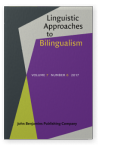Commentary
The dynamic nature of bilingualism
Article outline
- 1.The dynamic nature of bilingualism
- 2.Exposure and coactivation in the lexicon and phonology
- 3.Sketch of a new model
-
References
References (20)
References
Giancaspro, D. (2017). Heritage Speakers’ Production and Comprehension of Mood Morphology in Spanish. Rutgers University. ms.
Grosjean, F. (2015). Bicultural bilinguals. International Journal of Bilingualism, 19(5), 572–586. 

Hulsen, M. (2000). Language loss and language processing: three generations of Dutch migrants in New Zealand, unpublished Ph.D. dissertation, Radboud University.
Jackendoff, R. (1997). The architecture of the language faculty. Cambridge: MIT Press.
Jackendoff, R. (2011). What is the human language faculty?: Two views. Language, 87(3), 586–624. 

Lardiere, D. (1998). Dissociating syntax from morphology in a divergent L2 end-state grammar. Second language research, 14(4), 359–375. 

Lardiere, D. (2005). On morphological competence. In L. Dekydtspotter, R. Sprouse & A. Liljestrand (Eds.) Proceedings of the 7th generative approaches to second language acquisition conference (GASLA 2004). (178–192). Somerville: Cascadilla.
Malt, B. C., Li, P., Pavlenko, A., Zhu, H., & Ameel, E. (2015). Bidirectional lexical interaction in late immersed Mandarin-English bilinguals. Journal of Memory and Language, 821, 86–104. 

Mathison, L. (2016). Retrieval latency and word frequency of L1 verbal fluency in late L2 bilinguals. Paper presented at the
Linguistic Association of Canada and the United States (LACUS) Forum, St. Mary’s University, Halifax, Nova Scotia (Aug. 2-5).
Mayer, E. & Sánchez, L. (forthcoming) Feature variability in the bilingual-monolingual continuum: Clitics in Bilingual Quechua-Spanish, Bilingual Shipibo-Spanish and in Monolingual Andean Spanish. International Journal of Bilingual Education and Bilingualism.
Montrul, S. (2010). Dominant language transfer in adult second language learners and heritage speakers. Second Language Research, 26(3), 293–327. 

Montrul, S., Foote, R., & Perpiñán, S. (2008). Gender agreement in adult second language learners and Spanish heritage speakers: The effects of age and context of acquisition. Language Learning, 58(3), 503–553. 

Montrul, S. (2016). The acquisition of heritage languages. Cambridge: Cambridge University Press. 

Perez-Cortes, S. (2016). Acquiring obligatory and variable mood selection: Spanish heritage speakers and L2 learners’ performance in desideratives and reported speech contexts. Unpublished Ph.D. dissertation. Rutgers University.
Pérez Cortés, S., Putnam, M., & Sánchez, L. (2017). Incomplete Access: The difficulties of accessing features and representations in Heritage Languages in production and comprehension. Penn State U., Rutgers U. ms.
Putnam, M., Perez-Cortes, S. & Sánchez, L. (forthcoming). Feature Reassembly Hypothesis (in Language Attrition Contexts). Oxford: Oxford University Press.
Sánchez, L. (2004). Functional Convergence in the Tense, Evidentiality and Aspectual Systems of Quechua-Spanish Bilinguals. Bilingualism: Language and Cognition. 7(2). 147–162. 

Sorace, A. (2009). Theoretical and methodological interfaces in research on L2 ultimate attainment. Keynote address at
GASLA 10 conference, University of Illinois
,
Urbana-Champaign
.
Cited by (3)
Cited by three other publications
Krieger, Svenja & Miriam Geiss
Perpiñán, Sílvia
2020.
What can the ‘attrition via acquisition’ model predict?.
Second Language Research 36:2
► pp. 167 ff.

Sanchez, Liliana
2019.
Bilingual Alignments.
Languages 4:4
► pp. 82 ff.

This list is based on CrossRef data as of 21 october 2024. Please note that it may not be complete. Sources presented here have been supplied by the respective publishers.
Any errors therein should be reported to them.
